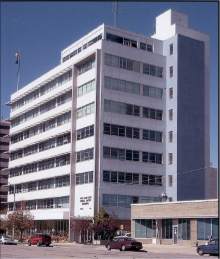This is an archived article that was published on sltrib.com in 2015, and information in the article may be outdated. It is provided only for personal research purposes and may not be reprinted.
Salt Lake City unveiled plans Friday to push at least three major pieces of city-owned property as construction sites for affordable housing.
The city's old cop shop, an abandoned bank building near 400 South and a disused industrial block on 800 South all will be offered up for mixed-use projects during the next 12 months.
The news came as Utah's capital officially launched its campaign to recruit a developer to renovate the dilapidated former Public Safety Building and turn the nine-story tower at 315 E. 200 South into housing and space for neighborhood businesses.
In a Friday news conference, Mayor Ralph Becker said the pitch to developers was aimed at preserving the aging building's historic value as well as adding hundreds of new apartments for residents with a range of incomes, including at least 50 units for the homeless. The other dwellings, Becker said, would be both affordable and market rate.
The city's request for proposals by a Nov. 20 deadline also envisions open space, ground-floor shops and additional new structures on the 2.72-acre parcel, much of which is now a parking lot.
"This building," the mayor said, "is important for a lot of reasons."
Becker said the renovation project could bring new economic vibrancy to the surrounding neighborhood while furthering his 5,000 Doors initiative of adding that many affordable-housing units within five years.
The mayor and other officials said the city was readying similar plans to market the former Barnes Bank Building at 431 S. 300 East and an industrial site near a TRAX line known as the former fleet block at 800 South between 300 West and 400 West for conversion to residential and other uses.
Built in the late 1950s, the old Public Safety Building — originally called the Northwest Pipeline building — is considered a prime example of International Style architecture. The building, listed on the National Register of Historic Places, served for years as offices for police and firefighters.
The city's plans drew praise Friday from historic preservationists, who have worked for nearly a decade to ensure the building wasn't demolished.
"This is a huge step forward in seeing preservation happen," said Kirk Huffaker, executive director of the Utah Heritage Foundation.
Prospects for the overhaul, Huffaker said, were helped by the successful 2002-2003 rehabilitation of the former First Security Bank Building at 405 S. Main St.
Now called the Ken Garff Building, that structure was also built in the International Style in the 1950s and is now a modernized corporate headquarters.
"There is an advantage to having already done one similar to this," Huffaker said. "Preservation of a building from this era can work and attract clientele."
If all goes to plan, the city expects to choose a developer by year's end and for the project to be completed within three years or so.
Michael Iverson, chairman of the Central City Community Council, said it could bring significant relief to a dense, walkable and appealing urban neighborhood that is hampered by a lack of housing. The crisis, Iverson said, was especially dire for students, young families, the elderly and the disabled.
"These folks," he said, "are being priced out of our affordable neighborhoods."
Launched in January, Becker's 5,000 Doors Initiative is cast as a call to action for developers, lenders and housing advocates to help address a shortage of moderately priced housing and rental units across the city.
The problem has been underscored by a recent apartment construction boom, with hundreds of upscale units being built for higher-income tenants but far fewer for working-class families.
Housing advocates say residents ideally should spend about a third of their income on housing. For want of affordable options, many are devoting half or more to housing, said Mike Akerlow, director of the city's Housing and Neighborhood Development Division.
"That," Akerlow said, "is prohibiting them from enjoying some of the basic essentials of life."
Twitter: @TonySemerad



